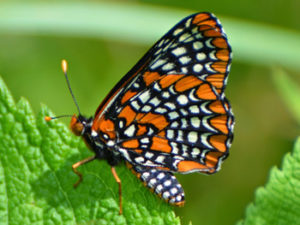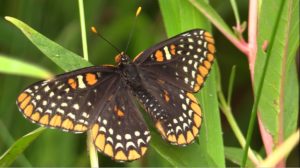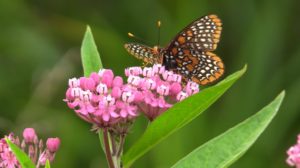Once common, the Baltimore Checkerspot Butterfly has become a rare sight in Maryland.
Its decline reflects changes in the environment. There has been a loss and degradation of its habitat. Heavy browsing by large deer populations has depleted host and nectar plants on which the butterfly depends. A loss of wetlands has also reduced its habitat.
Butterflies lay their eggs on host plants. The emerging caterpillars eat the host plant’s leaves. Although they may eat many leaves, the plants are built to survive. Most caterpillar species are highly selective about the type(s) of plant they can eat. The monarch caterpillar, for example, will only eat milkweed, Asclepias spp., leaves.
A beautiful, medium-sized butterfly, the Checkerspot has black wings with orange and white markings. Its wings span about 2 1/2 inches.

The butterfly has a large range from Canada south into the Eastern United States, according to the Maryland Department of Natural Resources (MD DNR). They are found as far south as the mountains of Virginia and North Carolina and west across the Great Lakes.
In the past, the species was found in 15 Maryland counties, most of which contained multiple colonies. Now, the DNR is only aware of 11 sites in seven counties. They are in Maryland’s western and central regions, including the Piedmont.
 The Baltimore Checkerspot Recovery Team (BCRT) of Maryland has been working to save the butterfly. They have been coordinating habitat restoration work as well working to capture, rear, and release them.
The Baltimore Checkerspot Recovery Team (BCRT) of Maryland has been working to save the butterfly. They have been coordinating habitat restoration work as well working to capture, rear, and release them.
Here are some of the ways you can help:
1) Volunteer with BCRT: Anyone who would like to help the Checkerspot butterfly should contact one of the organizations or agencies listed at the end of the blog.
These groups work to establish new Baltimore checkerspot colonies. Their work can involve propagating plants, rearing butterflies, planting turtlehead plants, building butterfly breeding enclosures, installing deer fencing, and removing invasive species.
2) Collect data: Report Baltimore checkerspot sightings to the Maryland Department of Natural Resources. The presence of a Checkerspot often leads to the discovery of an unknown colony. See the reporting rare species locations for more information and reporting forms. If you see a Checkerspot, take a photo of it, and if possible, forward it to BCRT.
 Finding candidate sites for wetland restoration activities can be difficult but very important. If you know of any sunny, wet meadows that support the White turtlehead plant and might serve as a potential restoration or introduction site in the Maryland Piedmont, contact BART.
Finding candidate sites for wetland restoration activities can be difficult but very important. If you know of any sunny, wet meadows that support the White turtlehead plant and might serve as a potential restoration or introduction site in the Maryland Piedmont, contact BART.
3) Education and fundraising: Students might hold fundraisers to support Baltimore checkerspot conservation activities. They could raise money for host and nectar plants; deer fencing; or supplies for building plant and butterfly-rearing facilities.
Students can also grow nectar and turtlehead plants at their schools for habitat restoration projects. Boy Scouts, Girl Scouts and other student groups might work on projects assisting restoration activities or building plant and butterfly-rearing facilities. A list of host and nectar plants can be found on the Baltimore Checkerspot Fact Sheet page.
Click here for several coloring pages that display the lifecycle of the Baltimore Checkerspot.
4) Advocate and participate: Contact your local and state representatives. Let them know that you care about the importance of preserving habitat for rare plants and animals. Support local conservation groups and efforts in your town or county. Join a local conservation group, become a Master Naturalist or contact the Washington Area Butterfly Club.
The Anita C. Leight Estuary Center is also looking for stewards of the Checkerspot. Check out their page here for more information.
A note of caution: Do not raise checkerspots on your own. They have specific habitat requirements and a complex life cycle. Most people lack the time, resources, training, or habitat to rear them.
Never collect caterpillars from the wild; this reduces the already threatened the number of wild butterfly colonies. It causes more harm than good. Without the proper resources, the butterflies will not survive. The best way to help the Baltimore checkerspots is through the BCRT.
To volunteer, contact one of the BCRT partnering organizations listed below:
Anita C. Leight Estuary Center
Black Hill Regional Park
Carroll County Public Schools
Cromwell Valley Park
Eden Mill Nature Center
Fountain Rock Park and Nature Center
Harford Glen Environmental Education Center
MA & PA Trail
Maryland Entomological Society
Maryland-National Capital Park and Planning Commission
Robert E. Lee Park
Robinson Nature Center
Rocky Gap State Park
U.S. Department of Agriculture
University of Colorado, CU Museum and Department of Ecology and Evolutionary Biology
University of Maryland Baltimore County
Washington Area Butterfly Club
Washington Suburban Sanitary Commission
The MD Department of Natural Resources’ webpage is http://dnr.maryland.gov/wildlife/Pages/plants_wildlife/BCRT/involved.aspx
CUTLINE
Photographer Matt Perry said, “We experienced a spectacular flight of Baltimore Checkerspots earlier this summer at our Nature Sanctuary in Clinton NY. It was the best I had ever seen. They laid many eggs and currently their larvae are covering our turtlehead plants.” Perry, who works at Spring Farms Cares, took the above photo.
